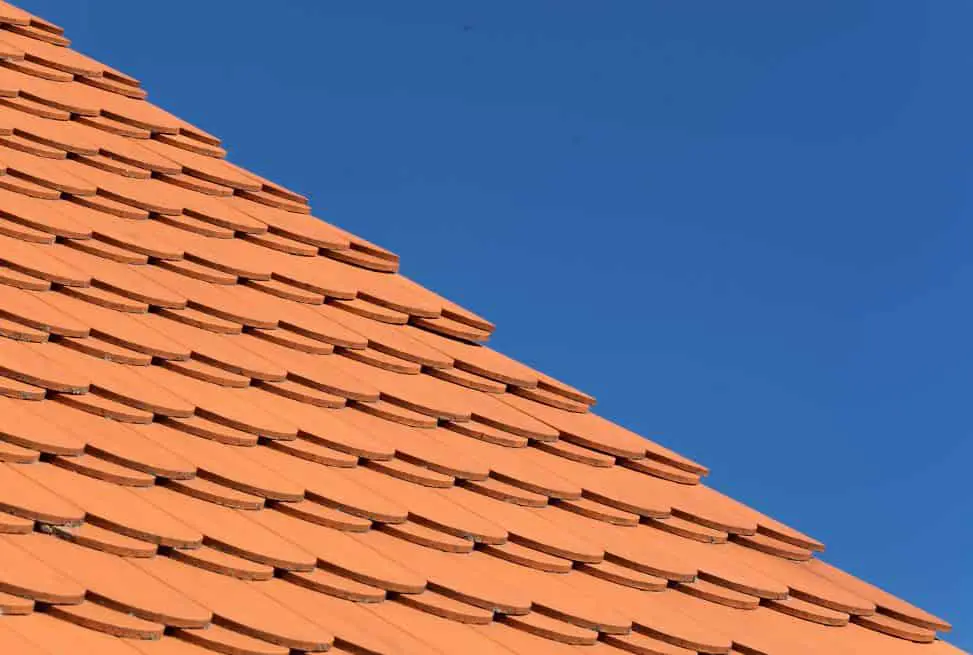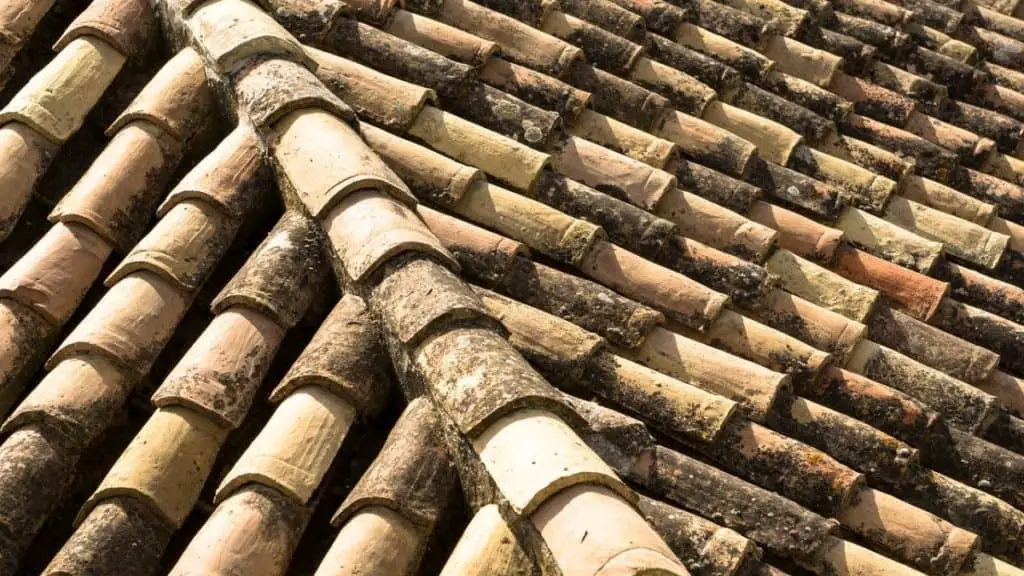
What are Clay Tiles?
Clay Tiles are most commonly made out of terracotta clay which is known for its distinct red color. Clay tile roofs have been around for hundreds of years which come to show that they can withstand the test of time.
Clay Tiles are often covered in a special glaze made up of chemical compounds like silica, manganese, fluxes and aluminum oxide which can increase the durability and alter the color.
The unique style, color, and durability make clay tiles the number one choice for many homeowners.
However, there is no such thing as a perfect roof. And not one single roofing option is the best for everyone. If you are thinking about getting Clay tiles as your next roof you will want to take into consideration some of these advantages and disadvantages of a clay tile roof system.
Worried About Doing the Work Yourself?
I recommend finding a professional roofing contractor through our trusted partner Home Advisor because they allow you to get up to 4 quotes for free. This allows you to compare and choose the best roofing professional for your needs. Check them out by clicking this link.
Pros:

1.Durability:
Clay tile roofs are very durable because they don’t weather as quickly as other roof systems. There still exist ancient clay tile roofs from Italy or Greece that have lasted for hundreds of years.
2.Fire Resistance:
Due to the stone-like qualities of Clay. Clay tiles are very fire resistant. They are considered a Class A fire rating which is the highest level fire rating. I imagine if your home was near a forest fire the clay tiles would do a lot to help protect your home from falling ash and embers helping to prevent it from catching fire.
3.Impact Resistance:
Although Clay Tiles can be fragile, they also can have a high impact resistance. Clay tiles can be made to withstand impact from 2-inch sized hail which gives it the highest impact rating of a Class 4 rating.
4.Wind Resistance:
If properly installed Clay tiles have strong wind resistance. The heavyweight and layered structure makes it able to resist wind speeds up to 200 mph.
5.Life Expectancy:
The life expectancy of Clay tile roof can range anywhere from 50 to 100 years. As long as it was installed properly and special care was taken not to damage the clay tiles you can expect them to last a long time.
6.Styles:
There is a vast variety of styles and color options available for clay tile roofs. Some of the style options include but shall not be limited to:
With these and many more style options you will be sure to find the look that fits your taste.
7.Restorations:
Clay tiles roofs are great for restoring older buildings that had a clay tile roof. Some manufacturers will let you order custom hand-sculpted tiles to match any previous style.
8.Eco-Friendly:
Clay tile roofs are eco-friendly because they are made from natural earth materials that can be recycled. The process to make tiles doesn’t release a lot of harmful chemicals into the air.
9.Energy Efficient:
Clay Tile roofs help to keep your home cool, especially in warm climates. The way the tiles are layered allows for good air-flow keeping your roof cool in the summer and warm in the winter.
10. Versatile:
Clay tile roofs are versatile meaning they can be used on both commercial and residential roofs. You can also find special tiles fitted for dome-shaped roof structures.
11.Maintenance:
Clay Tile roofs don’t need any regular maintenance to keep them going. They don’t need to be power washed or recoated with any special materials. The only time any maintenance would be needed was if a clay tile broke or cracked.
12.Repairs:
Clay tiles are fairly easy to repair. If a tile is broken or cracked it can easily be replaced without having to take off all the other tiles. I would still recommend that you hire a professional for any repairs that need to be done on your roof.
13. Rot Resistant:
Unlike Wood Shake and other roofing materials, clay tile will not rot. It is practically a stone roof so it will not get damaged by insects either. Sometimes insects like wasps may make nests in between the gaps of the clay tiles but this can be prevented by adding a cement filler between those gaps. This is something that is not necessary to do for everyone who is getting a clay tile roof. It just depends on what style of tiles you are using and where you live.
Cons:

1.Heavy:
Clay tiles are a heavyweight roof system. They can weigh anywhere from 788 lbs per square to 1780 lbs per square. This means if your roof is a 20 square roof that’s and upwards of 35,600 lbs resting above your head. You are going to want to ensure the framing and structure of your roof will be strong enough to support that kind of weight. If you previously had asphalt shingles and want to try using clay tiles. You will have to have your roof inspected and possibly restructured so it can support the additional weight.
2. Price:
Clay tiles are typically more expensive than other types of roofing materials like Concrete Tiles. The cost for Clay Tiles (excluding installation costs) is about $50 – $100 per square (1 square = 100 square feet). If you want to see how Clay Tiles compare to other roofing materials costs you can follow this link to look at charts of the costs of 17 different roofing materials and how their cost/lifespan compare.
3. Fragile:
Clay tile roofs can be fragile. If you ever need to walk on a clay tile roof you should be careful and know where to step to avoid breaking or cracking any tiles.
4.Technical Installation:
Clay roofs are very technical to install. You have to have the right pattern and shapes to fit the roof. You will also have to ensure that no water can get in. This will often require cutting tiles to fit certain shapes and angles. It is always best to hire a professional, especially if you do not have any experience installing clay tiles.
Are clay tiles right for you?

When deciding if a Clay tile roof is right for you, you should consider all the advantages and disadvantages of a clay roof. You should also make sure your roof has the proper slope needed for this roof system. Click this link to read about an article I wrote on how to find the slope of your roof.
You will also need to consider the budget. Can you afford to have a clay tile roof? Will you have to pay additional costs to have the structure of your roof reinforced to support the additional weight of a tiled roof? Is the cost/lifespan of the roof worth it? You can view the cost/lifespan for 17 different types of roofing materials here. All of these are things you must consider when deciding if this type of roof system is right for you.
Alternative Options:
If you are unsure if you want to go with Clay Tiles as your next roof. I would suggest taking a look at the other possible roof systems.
If you are looking for other tiled roofs you can check out any of these options:
If you are looking for any other type of roofing material you can take a look at my 17 Common Types of Roofing Materials Used Today which is a 10,000+ word article that I have spent months researching and writing. It gives you an overview of all the different types of roofing materials.
Related Questions:
Are Clay Tile roofs good? Clay tile roofs are a good choice for a roof because they are very durable and can last up to 100 years. One downside is that they are heavy so your roof may need to be reinforced to support the additional weight.
Which is better Clay or Concrete Tiles? Clay tiles look better and maintain their curb appeal throughout its life. While concrete tiles are more affordable and can fade in color.

